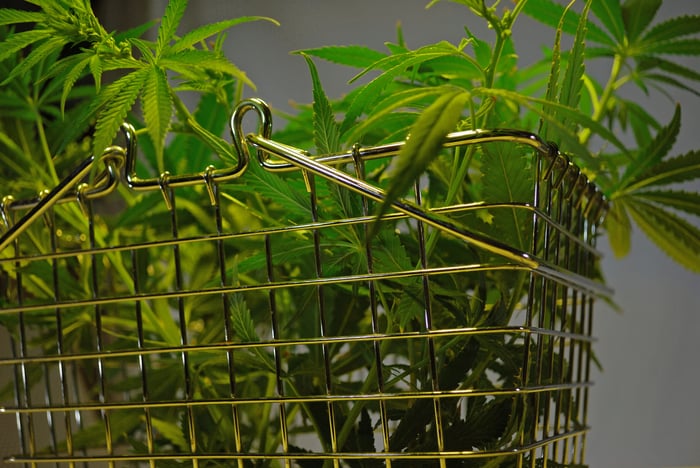Last year was one to forget for cannabis stock investors. Hopes were certainly high once the first quarter ended, with more than a dozen pot stocks advancing by more than 70%. The expected launch of cannabis derivatives, along with ongoing legalizations in the U.S., was forecast to lead to much-improved bottom lines for pot stocks.
However, when 2019 came to a close, most marijuana stocks were riding nine-month downtrends and bordering on multiyear lows. Supply issues in Canada and the inability for legal producers to be price-competitive with the black market in select U.S. states made for an ugly year for marijuana stocks.
Suffice it to say that this poor performance has made some investors a bit gun-shy about purchasing individual pot stocks. Traditionally, this is where exchange-traded funds (ETFs) would come into play.

Image source: Getty Images.
Cannabis ETFs might look like a smart way to play the budding marijuana market...
An ETF allows investors to buy into a targeted group of stocks, be it based on sector, industry, growth/value, or perhaps market cap, and instantly gain diversification with the click of a button. Since well-funded ETFs can hold dozens, hundreds, or even thousands of stocks, depending on their focus, this diversification means peace of mind for the investors in exchange for a relatively small annual fee (known as the net expense ratio).
Within the cannabis space, there are two well-known marijuana ETFs: the Horizons Marijuana Life Sciences ETF (HMLSF 0.69%) (HMMJ -0.30%) and the ETFMG Alternative Harvest ETF (MJ -1.34%). The Horizons Marijuana Life Sciences ETF was the first cannabis-focused fund to debut in 2017, while the ETFMG Alternative Harvest ETF is currently the world's largest by net assets.
With most of Wall Street forecasting that global cannabis sales will grow to between $50 billion and $200 billion annually by 2030, up from less than $11 billion worldwide in 2018, buying into a basket fund targeted at marijuana would seem like a great idea. There's just one problem...these ETFs love to put most of their eggs into just a few baskets.

Image source: Getty Images.
...But they have a fatal flaw
Make no mistake about it, the 0.75% net expense ratio investors pay to own a piece of the Horizons Marijuana Life Sciences ETF and ETFMG Alternative Harvest ETF is a small price to pay compared to what could happen to their capital due to a lack of diversification.
On one hand, I do understand that you're not going to get a whole lot of diversification by investing in a single industry, cannabis. There are only so many companies involved in the direct and ancillary marijuana space, although I follow more than four dozen that are at least modestly sized ($100 million-plus market cap). The thing is, these ETFs are perfectly comfortable taking their assets and primarily piling them into just a few companies.
For instance, the Horizons Marijuana Life Sciences ETF, which had close to $369 million in net assets as of this past weekend, listed 49 holdings as of Jan. 17, 2020. However, as of Jan. 24, its eight largest holdings comprised 71.6% of invested assets, including Canopy Growth (CGC -1.01%) and Cronos Group (CRON -0.42%), which combined for nearly a quarter of this ETFs entire weighting. Understandably, Canopy and Cronos are the two most cash-rich pot stocks in the entire industry among pure plays, but this cash hasn't helped their performance, as operating losses have continued for both companies. In fact, on an operating basis, only two of these top eight holdings -- Charlotte's Web and Scotts Miracle-Gro -- have ever generated an operating profit.
It's a similar story with the ETFMG Alternative Harvest ETF, albeit the lack of diversification isn't as extreme. Of its 37 holdings, the top 8 account for 51% of total assets invested. Similar to before, Canopy Growth and Cronos Group remain the two largest holdings, although they account for "only" 17.8% of invested assets in the Alternative Harvest ETF.
Maybe the real kick in the behind here is that there is a handful of profitable direct and ancillary players in the weed industry, but neither ETF has given much representation to these companies.

Image source: Getty Images.
It's time to educate yourself
It's possible these ETFs could do just fine over the long run and I'm making a big stink over nothing. It's also noteworthy that a rebalancing of these ETFs happens on a quarterly basis, meaning a more appropriate weighting for these holdings might be earned over time. But I believe the lack of weighting diversification of both cannabis ETFs provides more than enough evidence that investors should look to educate themselves and invest in the marijuana industry without leaning on basket funds.
For example, earlier today, I highlighted six cannabis stocks that have generated a real operating profit at some point, without the aid of one-time benefits or fair-value adjustments. Though this doesn't guarantee that these companies will succeed over the long run, their ability to generate an operating profit without the need for one-time accounting adjustments demonstrates promise, and perhaps this is a place to begin your research. Also, these six pot stocks are direct players and don't include a number of other profitable ancillary companies, such as Scotts Miracle-Gro.
Furthermore, most brokerages have eliminated the commission fees associated with purchasing stocks, meaning the primary barrier to creating your own diversified portfolio of companies (without having a boatload of cash on hand) has been removed. There's absolutely nothing stopping investors from learning about marijuana stocks and making educated investment decisions to create their own diversified portfolios.





